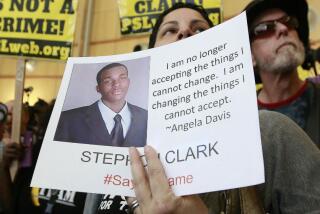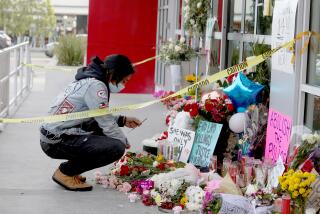Attorneys in Tuffree Trial Try to Reenact Killing of Officer
Using a series of dramatic props, attorneys in the Daniel Allan Tuffree murder trial offered conflicting scenarios Thursday of how Simi Valley Police Officer Michael Clark was shot and killed.
First, they rolled the bullet-riddled kitchen window from Tuffree’s home into the center of the courtroom. The window was mounted in a thick, wooden frame at its approximate height as in the house.
Then, attorneys used red laser pens and a mannequin dressed in Clark’s actual bloodstained uniform to re-create the deadly gunfight that broke out in a matter of seconds over Tuffree’s kitchen sink last summer.
But after hours of testimony Thursday from a firearms expert, the jury was left with no definitive explanation of how Clark was positioned as he was gunned down, or who fired the first shot.
Tuffree has been charged with first-degree murder in the shooting death of Clark, 28. He also faces charges of armed assault and attempted murder for allegedly firing at a second officer who had come to his home Aug. 4, 1995, to check his health after reports that he had been drinking wine and taking Valium all day.
Attorneys for the 49-year-old former schoolteacher concede that Tuffree shot and killed Clark. But they argue that he fired in self-defense because Clark fired first.
For days, Tuffree’s broken window has stood in the corner of Superior Court Judge Allan L. Steele’s courtroom, draped with yellow evidence tape near the defense table. On Thursday, the big exhibit took center stage.
“This is the kitchen window we have been talking about,” said firearms expert Paul Dougherty, explaining that tiny bullet holes in the glass provide valuable evidence as to the direction of gunshots and probable location of the men as they were shooting.
Although most of the glass is intact as a result of clear tape holding it together, a two-foot section is missing where a SWAT team’s armored truck rammed into the house to rescue Clark.
In addition, Dougherty said five shell casings were found in Tuffree’s kitchen--three in the sink, one on the counter and another in a cup--which show that he was firing near the window.
During his testimony, Dougherty marked the preserved bullet holes “in” and “out” to indicate which shots came from Tuffree inside the home and which came from the police officers outside.
As a witness for the prosecution, Dougherty pointed a red laser like a weapon to draw a visual line for the jury of how Tuffree’s bullets may have pierced the window and then struck Clark.
A district attorney’s investigator who was assisting held the mannequin in a slightly bent position to show where Clark may have been standing when Tuffree shot him.
Under the prosecution’s scenario, Tuffree was standing behind the sink, aiming his gun down at Clark when he fired the fatal bullet that hit the officer in the shoulder, killing him after it punctured his jugular vein.
Splinters of glass, like tiny projectiles, were lodged in Clark’s uniform near his shoulder wound, Dougherty said, indicating that he was close to the window when he was shot.
“He had to be close enough to receive those on the breakage of the glass,” Dougherty said. “The closest he could have been would have been 3 to 3 1/2 feet.”
But on cross-examination, Howard Asher, one of two deputy public defenders representing Tuffree, pointed to an autopsy report that showed the fatal bullet traveled through Clark at a 10-degree upward angle--not a downward angle like the prosecution’s scenario suggested.
Asher then propped the uniform-clad dummy at a different location on the outside of the kitchen window, asking Dougherty if it was possible that Clark was struck when he was elsewhere in Tuffree’s backyard.
Dougherty acknowledged that no one knows for certain what position Clark was in when he was shot with two hollow-point bullets--one from a .40-caliber Glock semiautomatic pistol and another from a .44 Magnum revolver. There was also no way to be sure which bullet holes in the window were created first, he said.
“I think you indicated that there is no way of knowing which of these bullet holes came first,” Asher asked.
“That is correct,” Dougherty replied.
Testimony is scheduled to resume Tuesday.
More to Read
Sign up for Essential California
The most important California stories and recommendations in your inbox every morning.
You may occasionally receive promotional content from the Los Angeles Times.










